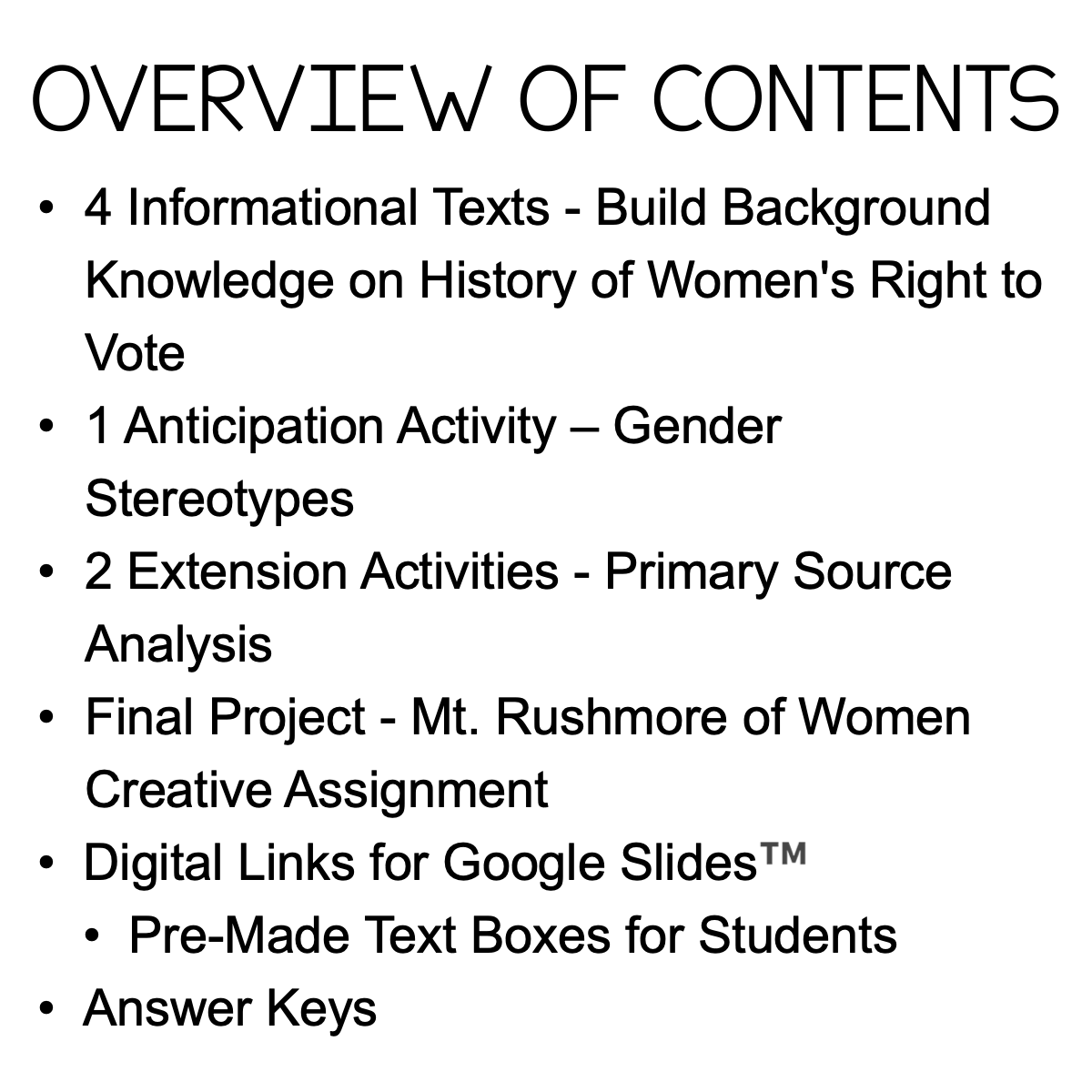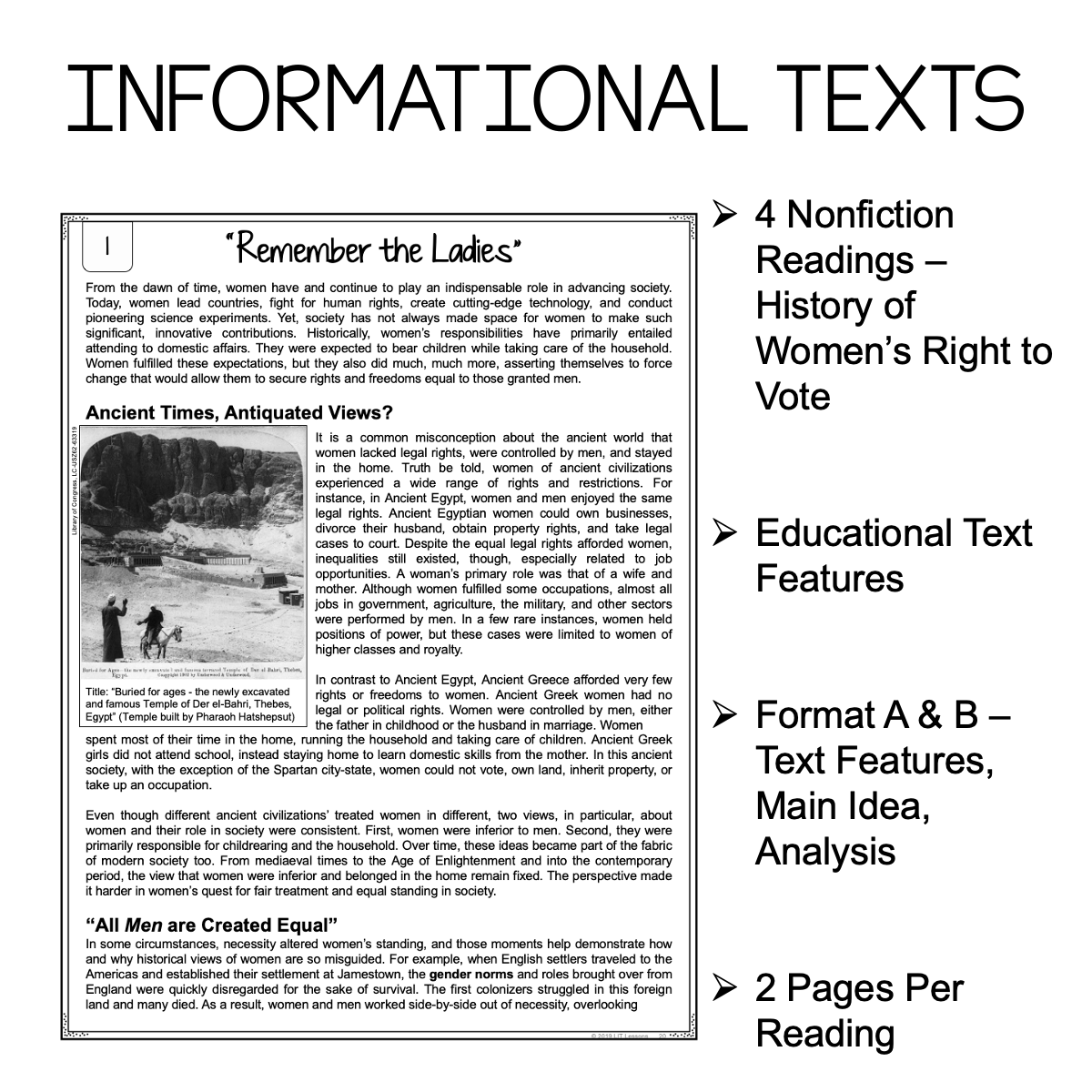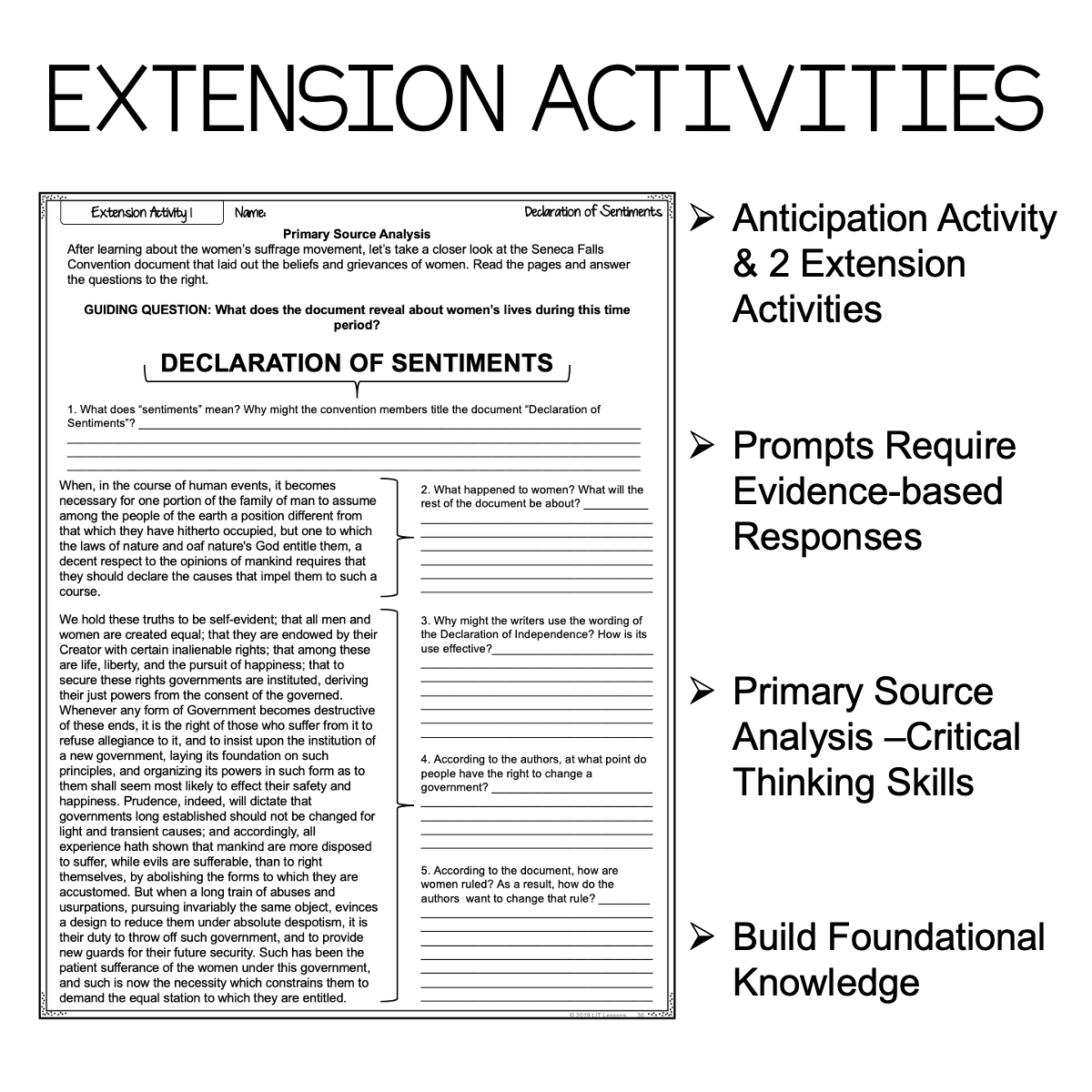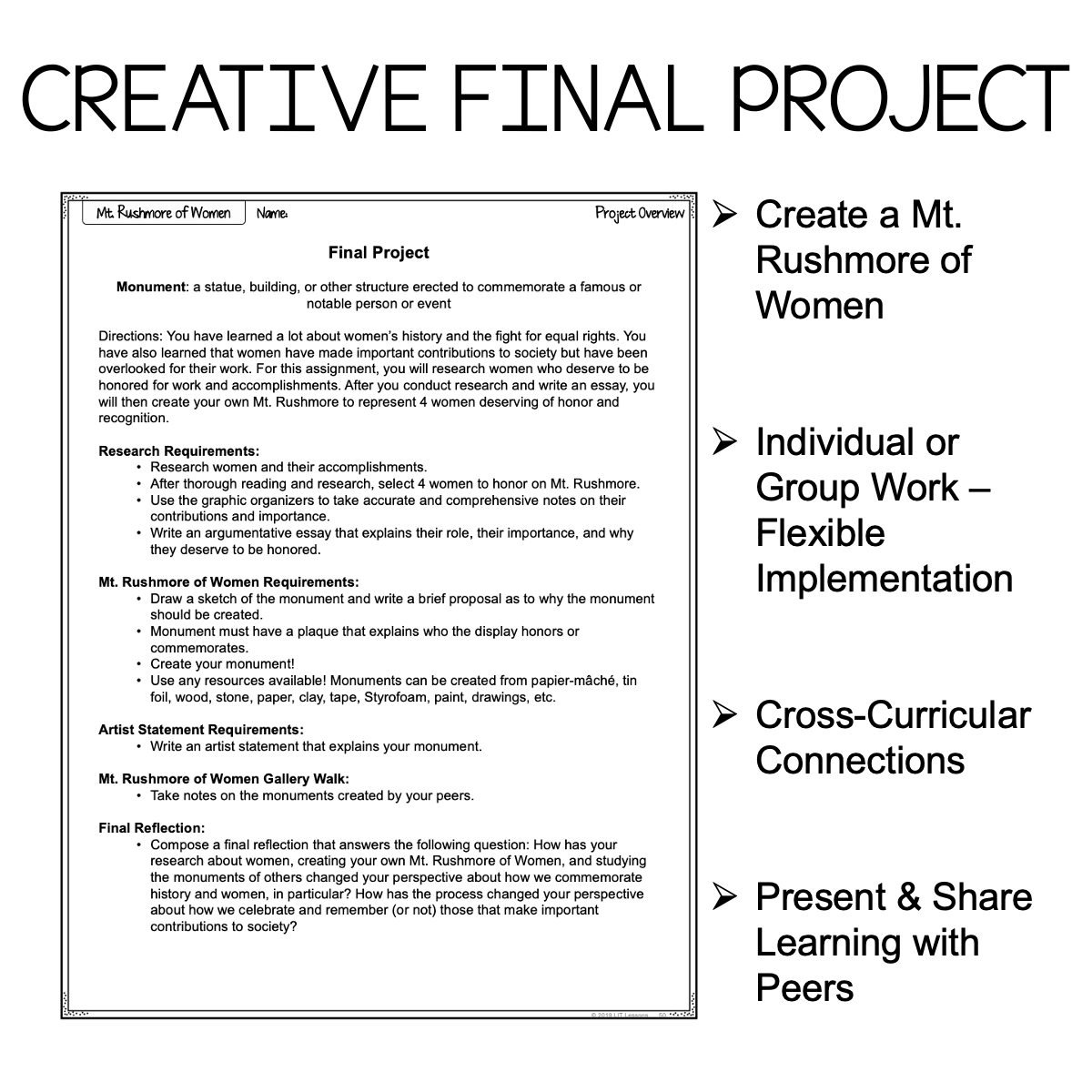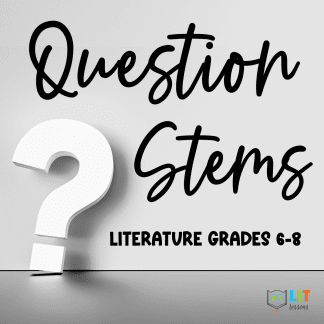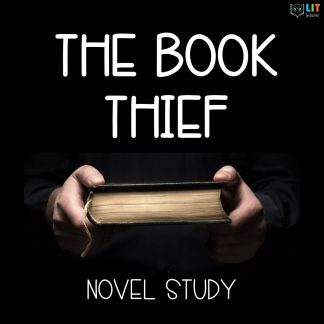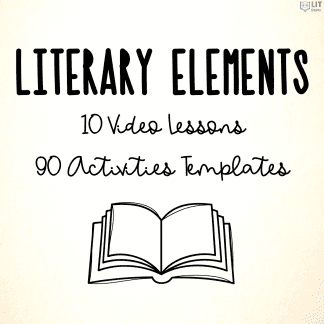Women’s History Month Project Readings Activities
You can only add to a wishlist if you have an account, please register now.
Create an Account$5
Women’s History Month Project – Snapshot of Resources:
- 4 Informational Texts – Build Background Knowledge on History of Women’s Right to Vote
- 1 Anticipation Activity – Gender Stereotypes
- 2 Extension Activities – Primary Source Analysis
- Final Project – Mt. Rushmore of Women Creative Assignment
- Digital Links for Google Slides™
- Pre-Made Text Boxes for Students
- Answer Keys
The fight for gender equality has been a long struggle, and the discrimination women have faced in their daily experiences has taken many forms. Nevertheless, there is much to celebrate. Thanks to the tireless spirit of countless women, not only have many realized remarkable achievements but also much progress toward improved gender equality. This set of resources will help students build their background knowledge about women’s history, engage in activities to better understand the challenges women have and continue to face, and complete a project that celebrates the influence of women. All the resources are aligned to Common Core State Standards, and will aid students in developing essential skills, such as close-reading, critical thinking, examining perspectives, and conducting and presenting research, among others. In the end, students not only will have expanded their understanding of women’s historical contributions but also developed their abilities to think, research, and write.
Nonfiction Readings: The 4 close reading lessons develop students’ knowledge about women’s history. Each informational text includes two sets of questions – one comprehension set and one analysis set – that will develop essential skills aligned to the Common Core State Standards for reading informational texts. After practicing over the course of the unit, you can be confident your students will have mastered numerous skills, such as:
- Citing textual evidence to support analysis of the text
- Identifying and analyzing text features
- Summarizing the main idea of a text with supporting details
- Determining the meaning of words or phrases as used in the text
- Determining author’s purpose and its effects
- Identifying and analyzing arguments and specific claims in a text
- Identifying and analyzing text structure and its effects
- Identifying and analyzing cause and effect
Anticipation Lesson: The anticipation lesson sees students take on the role of hiring a candidate for employment. Students will analyze a biography, evaluate their findings, and come to a final decision. However, there is a twist! The students will be reading the same biography just with different names – Margaret and Michael. After completing the evaluation, students will analyze the data from their collective evaluations, and reflect on what that data reveals about views on gender. The lesson serves as a great springboard to examining stereotypes, women’s history, and the challenges women have and continue to face.
Extension Activities: The 2 extension activities take your students deeper. Each presents an opportunity for students to better understand the struggle for women’s equality. Through close readings of historical documents and case studies, students will study the challenges women have and still face in their efforts to be treated as equals. As a result of their analysis, students will develop new perspectives about how women have made change over time and the obstacles that still remain to full equality.
- Primary Source Analysis – Declaration of Sentiments: For the primary source activity, students will engage in a close reading of the Declaration of Sentiments. Students will analyze language to discern meaning, intent, and the values conveyed as they consider why the document was created. After students analyze the document, they will then draft their own version based on the inequalities and issues they believe women face today.
- The Suffrage Debate: Using primary source documents from the late 19th and early 20th centuries, students will analyze the arguments in support of or opposed to women’s suffrage. Students will examine six documents, students to learn more about how women were viewed during that period. The close reading and questions will help them understand contemporary attitudes as reflected through the documents.
Mt. Rushmore of Women Project: The Mt. Rushmore project provides a different avenue for students to engage at a deeper level with women’s history. Students will identify four women they would memorialize, conduct research to justify their selections, and create a representation of them. This monument project is a great way to have students research women’s history and consider the presentation of women in history. *Requires Internet access and additional materials not provided.*
Digital Links: This resource is also technology friendly! It can be utilized in classrooms where computers or tablets are central to instruction because the resource has been adapted for digital completion. The resource includes links for students to complete the student pages in Google Slides™. For instance, students can work with the documents in Google Drive™ or via Google Classroom. With these links, you can have students complete their work online. (NOTE: Not all assignments are conducive to digital completion; however, the pages are still provided in the digital format.) All they will have to do is create a text box! There are links for every student work page, making the format friendly not only for technology but also trees.
The entire resource and its inclusive set of questions allow for multiple potential uses based on your determination about when and where it would be most helpful. All aspects of the assignments, though, are aligned to the Common Core State Standards in order for students to have ample opportunities to practice and demonstrate their knowledge across numerous, essential literary skills.
- Editable
- 69.7 MB
- 79 Pages
- This downloadable resource supplies one single-teacher license for use in your classroom.
- Photocopying of this product is allowed only for the classroom use of the purchaser.
- Replication of this product, in whole or in part, for commercial sale or broader distribution is strictly prohibited.
- This product also may NOT be shared electronically, digitally, or otherwise in a manner that violates the Terms of Use detailed by LIT Lessons.
- For explicit information on permissions, please see the Terms of Use document included with this resource. Thank you for your cooperation and understanding.
Women’s History Month Project – Snapshot of Resources:
- 4 Informational Texts – Build Background Knowledge on History of Women’s Right to Vote
- 1 Anticipation Activity – Gender Stereotypes
- 2 Extension Activities – Primary Source Analysis
- Final Project – Mt. Rushmore of Women Creative Assignment
- Digital Links for Google Slides™
- Pre-Made Text Boxes for Students
- Answer Keys
The fight for gender equality has been a long struggle, and the discrimination women have faced in their daily experiences has taken many forms. Nevertheless, there is much to celebrate. Thanks to the tireless spirit of countless women, not only have many realized remarkable achievements but also much progress toward improved gender equality. This set of resources will help students build their background knowledge about women’s history, engage in activities to better understand the challenges women have and continue to face, and complete a project that celebrates the influence of women. All the resources are aligned to Common Core State Standards, and will aid students in developing essential skills, such as close-reading, critical thinking, examining perspectives, and conducting and presenting research, among others. In the end, students not only will have expanded their understanding of women’s historical contributions but also developed their abilities to think, research, and write.
Nonfiction Readings: The 4 close reading lessons develop students’ knowledge about women’s history. Each informational text includes two sets of questions – one comprehension set and one analysis set – that will develop essential skills aligned to the Common Core State Standards for reading informational texts. After practicing over the course of the unit, you can be confident your students will have mastered numerous skills, such as:
- Citing textual evidence to support analysis of the text
- Identifying and analyzing text features
- Summarizing the main idea of a text with supporting details
- Determining the meaning of words or phrases as used in the text
- Determining author’s purpose and its effects
- Identifying and analyzing arguments and specific claims in a text
- Identifying and analyzing text structure and its effects
- Identifying and analyzing cause and effect
Anticipation Lesson: The anticipation lesson sees students take on the role of hiring a candidate for employment. Students will analyze a biography, evaluate their findings, and come to a final decision. However, there is a twist! The students will be reading the same biography just with different names – Margaret and Michael. After completing the evaluation, students will analyze the data from their collective evaluations, and reflect on what that data reveals about views on gender. The lesson serves as a great springboard to examining stereotypes, women’s history, and the challenges women have and continue to face.
Extension Activities: The 2 extension activities take your students deeper. Each presents an opportunity for students to better understand the struggle for women’s equality. Through close readings of historical documents and case studies, students will study the challenges women have and still face in their efforts to be treated as equals. As a result of their analysis, students will develop new perspectives about how women have made change over time and the obstacles that still remain to full equality.
- Primary Source Analysis – Declaration of Sentiments: For the primary source activity, students will engage in a close reading of the Declaration of Sentiments. Students will analyze language to discern meaning, intent, and the values conveyed as they consider why the document was created. After students analyze the document, they will then draft their own version based on the inequalities and issues they believe women face today.
- The Suffrage Debate: Using primary source documents from the late 19th and early 20th centuries, students will analyze the arguments in support of or opposed to women’s suffrage. Students will examine six documents, students to learn more about how women were viewed during that period. The close reading and questions will help them understand contemporary attitudes as reflected through the documents.
Mt. Rushmore of Women Project: The Mt. Rushmore project provides a different avenue for students to engage at a deeper level with women’s history. Students will identify four women they would memorialize, conduct research to justify their selections, and create a representation of them. This monument project is a great way to have students research women’s history and consider the presentation of women in history. *Requires Internet access and additional materials not provided.*
Digital Links: This resource is also technology friendly! It can be utilized in classrooms where computers or tablets are central to instruction because the resource has been adapted for digital completion. The resource includes links for students to complete the student pages in Google Slides™. For instance, students can work with the documents in Google Drive™ or via Google Classroom. With these links, you can have students complete their work online. (NOTE: Not all assignments are conducive to digital completion; however, the pages are still provided in the digital format.) All they will have to do is create a text box! There are links for every student work page, making the format friendly not only for technology but also trees.
The entire resource and its inclusive set of questions allow for multiple potential uses based on your determination about when and where it would be most helpful. All aspects of the assignments, though, are aligned to the Common Core State Standards in order for students to have ample opportunities to practice and demonstrate their knowledge across numerous, essential literary skills.
- Editable
- 69.7 MB
- 79 Pages
- This downloadable resource supplies one single-teacher license for use in your classroom.
- Photocopying of this product is allowed only for the classroom use of the purchaser.
- Replication of this product, in whole or in part, for commercial sale or broader distribution is strictly prohibited.
- This product also may NOT be shared electronically, digitally, or otherwise in a manner that violates the Terms of Use detailed by LIT Lessons.
- For explicit information on permissions, please see the Terms of Use document included with this resource. Thank you for your cooperation and understanding.



You Might Also Like
Frequently Asked Questions
Yes! Each novel study contains a wealth of resources that allow you to differentiate for your students.
If you have a specific question about the resource, its contents, or potential uses, please reach out HERE. We are happy to answer all and any questions to make sure the product is a right fit for you and your classroom context.
Each resource has been aligned to the Common Core State Standards for its applicable grades and subject. The specific standards for each resource are listed when you buy a full unit or in the implementation notes for certain products.


